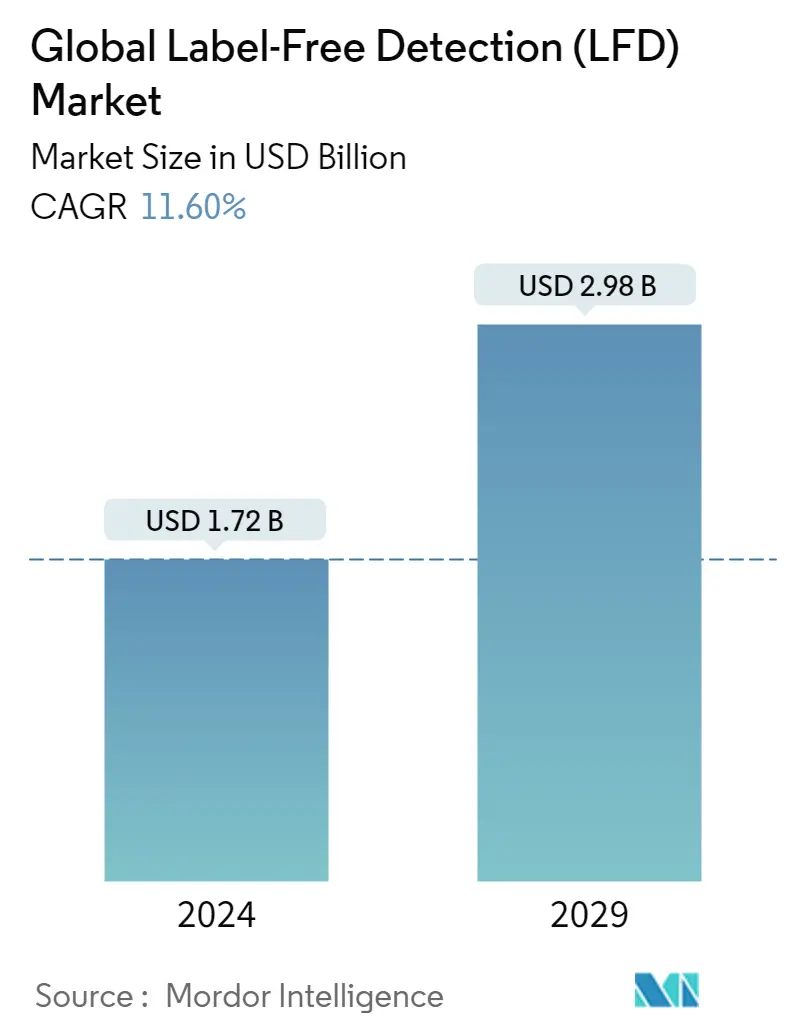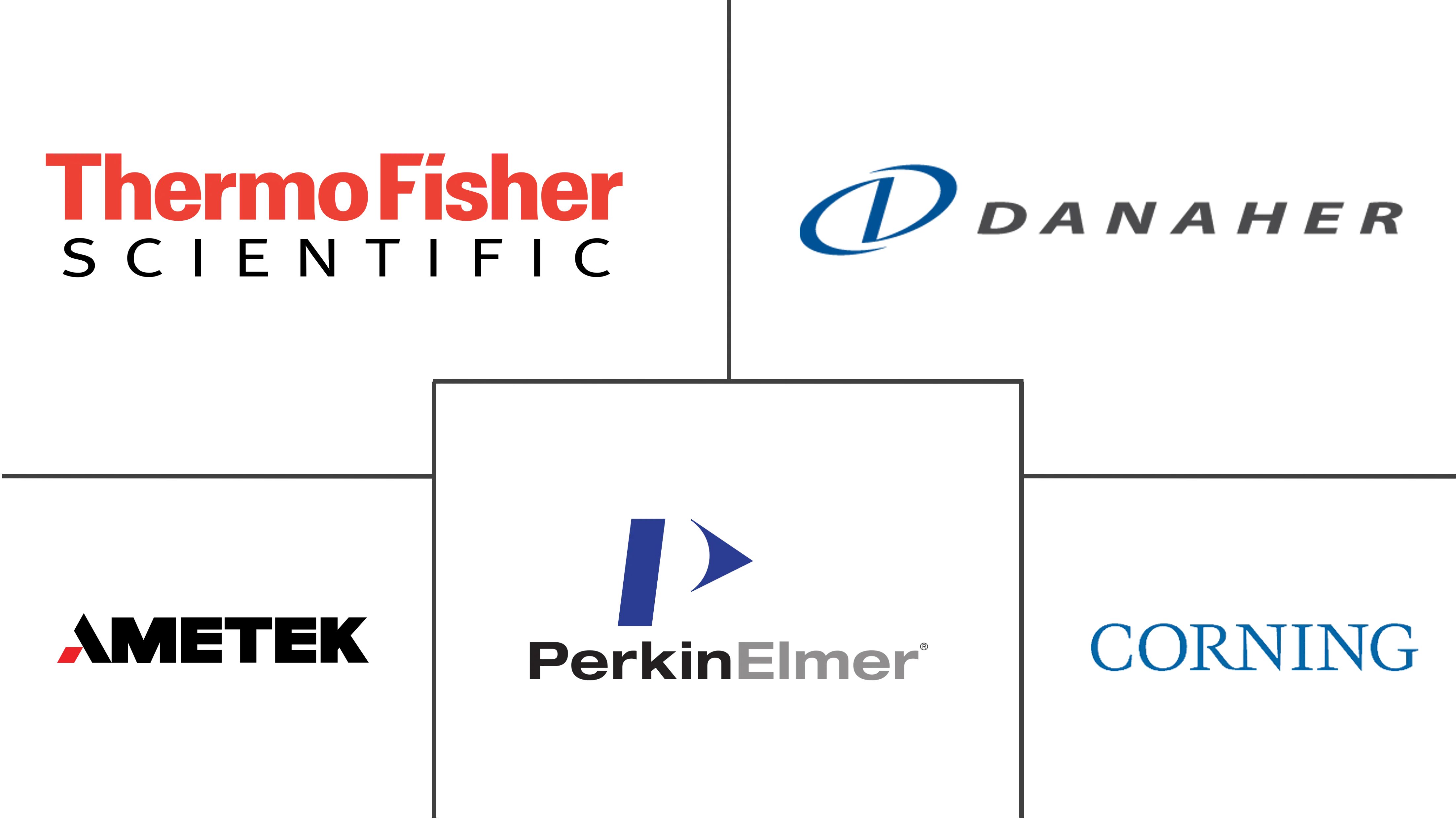Market Size of Global Label-Free Detection (LFD) Industry

| Study Period | 2019 - 2029 |
| Market Size (2024) | USD 1.72 Billion |
| Market Size (2029) | USD 2.98 Billion |
| CAGR (2024 - 2029) | 11.60 % |
| Fastest Growing Market | Asia Pacific |
| Largest Market | North America |
Major Players
*Disclaimer: Major Players sorted in no particular order |
Label-Free Detection (LFD) Market Analysis
The Global Label-Free Detection Market size is estimated at USD 1.72 billion in 2024, and is expected to reach USD 2.98 billion by 2029, growing at a CAGR of 11.60% during the forecast period (2024-2029).
The COVID-19 pandemic has had a substantial impact on the label-free detection market initially. The strict lockdowns and government regulations intended to slow down the spread of COVID-19 resulted in a decrease in demand for products in the initial days of the pandemic. According to researchers based at ETH Zurich (Switzerland), Localized Surface Plasmon Resonance (LSPR) demonstrated a high degree of accuracy and sensitivity when tasked with detecting COVID-19 RNA. Surface Plasmon Resonance is one of the major technologies used in label-free detection. This is a significant indicator of market growth. In addition to this, label-free products such as SPR systems and biosensors are also being used for COVID-19 research. However, Research & Development labs are now operating below 50% of normal capacity. According to an analysis of studies based on ClinicalTrials.gov in 2020, among the 2522 clinical trial registry entries that were suspended, terminated, or withdrawn between December 1, 2019, and May 5, 2020, around 44% were closed with a reported reason that explicitly mentioned COVID-19. These factors could hinder the growth of the market.
The main advantage of LFD techniques is that more direct information can be acquired as the method uses only native proteins and ligands. Innovations in LFD techniques include modification of mass spectrometry to develop surface-enhanced laser desorption/ionization (SELDI) time of flight (TOF)- mass spectrometry (MS) which is an innovative approach that offers on-chip purification of the proteins of interest and subsequent ionization of the retained molecules to be detected. In 2021, The latest innovation in differential scanning calorimetry (DSC) from Spectris (UK) has been created specifically for regulated environments and delivers essential data to guide biopharmaceutical development. Furthermore, in June 2022, Agilent Technologies Inc. launched its new innovative and intelligent MS systems, Agilent 5977C GC/MSD, 6475 triple quadrupole LC/MS system, 7000E GC/TQ, and the 7010C GC/TQ, at the 70th ASMS Conference on Mass Spectrometry and Allied Minnesota. The advanced MS systems offer advanced sensitivity of detection, automated sample reinjection function, high throughput, efficiency, and many other advanced features which simplify lab operations. These technological advancements have increased the adoption of label-free technologies by pharmaceutical and biopharmaceutical companies as well as academic research institutes for biomolecular analysis during drug discovery. This is expected to drive market growth. Furthermore, with the introduction of new innovations in label-free detection technologies, the market is expected to experience significant growth.
Relatively new in the well-established field of High-throughput screening, label-free technologies provide opportunities for probing biomolecular interactions without spatial interference or the auto-fluorescent or quenching effects of labels. On average, it takes at least ten years for a new drug to complete the journey from initial discovery to the marketplace. As per the Congressional Budget Office data published in April 2021, the average cost of research & development for each successful drug is estimated to be around USD 2.6 billion (Pharmaceutical Research and Manufacturers of America-PhRMA). With escalating cost pressures and increasingly complex disease targets, improving productivity in early drug discovery processes has been challenging. Initially, low throughput was a major challenge associated with label-free technologies. However, the introduction of Surface plasmon resonance-based label-free systems with higher throughput has helped increase overall operational efficiency while providing the high-quality data needed to make informed decisions.
Thus, the aforementioned factors are driving the growth of the market. However, at present, there is a shortage of such professionals, forcing most companies to opt for conventional methods such as cell-based assays and fluorescence- and radioactive-labeled instruments. This poses a challenge to the label-free detection market.
Label-Free Detection (LFD) Industry Segmentation
As per the scope of the report, label-free detection (LFD) is a method for detecting biomolecules and their interactions. The LFD method has made tremendous advancements due to the combination of knowledge in material sciences, computational design, and nanofabrication. The label-free detection (LFD) market is segmented by Product (Consumables, Instruments), Technology (Mass Spectrometry, Surface Plasmon Resonance, Bio-Layer Interferometry, Isothermal Titration Calorimetry, Differential Scanning Calorimetry, and Other LFD Technologies), By Application (Binding Kinetics, Binding Thermodynamics, Endogenous Receptor Detection, Hit Confirmation, Lead Generation, and Other Applications), By End-user (Pharmaceutical & Biotechnology Companies, Academic & Research Institutes, and Contract Research Organizations), and Geography (North America, Europe, Asia-Pacific, Middle East and Africa, and South America). The market report also covers the estimated market sizes and trends for 17 different countries across major regions globally. The report offers the value (in USD million) for the above segments.
| By Product | ||||
| ||||
| Instruments |
| By Technology | |
| Mass Spectrometry | |
| Surface Plasmon Resonance (SPR) | |
| Bio-Layer Interferometry | |
| Isothermal Titration Calorimetry | |
| Differential Scanning Calorimetry | |
| Other LFD Technologies |
| By Application | |
| Binding Kinetics | |
| Binding Thermodynamics | |
| Endogenous Receptor Detection | |
| Hit Confirmation | |
| Lead Generation | |
| Other Applications |
| By End-User | |
| Pharmaceutical & Biotechnology Companies | |
| Academic & Research Institutes | |
| Contract Research Organizations |
| Geography | ||||||||
| ||||||||
| ||||||||
| ||||||||
| ||||||||
|
Global Label-Free Detection (LFD) Market Size Summary
The label-free detection market is poised for significant growth, driven by advancements in technology and increasing applications in biomolecular analysis. This market, which includes techniques such as Surface Plasmon Resonance (SPR) and biosensors, is gaining traction due to its ability to provide direct information using native proteins and ligands, eliminating the need for labels that can interfere with results. Innovations like the modification of mass spectrometry and the development of advanced systems by companies such as Agilent Technologies and Spectris are enhancing the sensitivity and efficiency of these technologies. These advancements are particularly beneficial for pharmaceutical and biopharmaceutical companies, as they streamline drug discovery processes and improve productivity in early-stage research. Despite challenges such as a shortage of skilled professionals and the initial impact of the COVID-19 pandemic, the market is expected to expand, supported by increasing clinical research funding and the growing prevalence of chronic diseases.
North America leads the global label-free detection market, bolstered by technological advancements and substantial government funding. The region's growth is further fueled by the rising incidence of chronic diseases, which drives demand for advanced detection technologies in clinical research. The market is characterized by a competitive landscape with major players like Thermo Fisher Scientific, PerkinElmer Inc., and Cytiva (Danaher Corporation) engaging in strategic initiatives such as mergers, acquisitions, and product launches to strengthen their market positions. These companies are focusing on product innovations and expanding their geographical presence to cater to a diverse range of end users. As the demand for label-free detection technologies continues to rise, driven by both technological advancements and the need for efficient disease detection methods, the market is expected to experience robust growth over the forecast period.
Global Label-Free Detection (LFD) Market Size - Table of Contents
-
1. MARKET DYNAMICS
-
1.1 Market Overview
-
1.2 Market Drivers
-
1.2.1 Increasing R&D Activities Through Research Partnerships Between Pharmaceutical Companies and Academic Institutes
-
1.2.2 Innovations in Label-free Detection Technologies
-
-
1.3 Market Restraints
-
1.3.1 High Cost of Instruments
-
1.3.2 Issues in Sensitivty and Throughput
-
-
1.4 Porter Five Forces
-
1.4.1 Threat of New Entrants
-
1.4.2 Bargaining Power of Buyers/Consumers
-
1.4.3 Bargaining Power of Suppliers
-
1.4.4 Threat of Substitute Products
-
1.4.5 Intensity of Competitive Rivalry
-
-
-
2. MARKET SEGMENTATION (Market Size by Value - USD million)
-
2.1 By Product
-
2.1.1 Consumables
-
2.1.1.1 Biosensor Chips
-
2.1.1.2 Microplates
-
-
2.1.2 Instruments
-
-
2.2 By Technology
-
2.2.1 Mass Spectrometry
-
2.2.2 Surface Plasmon Resonance (SPR)
-
2.2.3 Bio-Layer Interferometry
-
2.2.4 Isothermal Titration Calorimetry
-
2.2.5 Differential Scanning Calorimetry
-
2.2.6 Other LFD Technologies
-
-
2.3 By Application
-
2.3.1 Binding Kinetics
-
2.3.2 Binding Thermodynamics
-
2.3.3 Endogenous Receptor Detection
-
2.3.4 Hit Confirmation
-
2.3.5 Lead Generation
-
2.3.6 Other Applications
-
-
2.4 By End-User
-
2.4.1 Pharmaceutical & Biotechnology Companies
-
2.4.2 Academic & Research Institutes
-
2.4.3 Contract Research Organizations
-
-
2.5 Geography
-
2.5.1 North America
-
2.5.1.1 United States
-
2.5.1.2 Canada
-
2.5.1.3 Mexico
-
-
2.5.2 Europe
-
2.5.2.1 Germany
-
2.5.2.2 United Kingdom
-
2.5.2.3 France
-
2.5.2.4 Italy
-
2.5.2.5 Spain
-
2.5.2.6 Rest of Europe
-
-
2.5.3 Asia-Pacific
-
2.5.3.1 China
-
2.5.3.2 Japan
-
2.5.3.3 India
-
2.5.3.4 Australia
-
2.5.3.5 South Korea
-
2.5.3.6 Rest of Asia-Pacific
-
-
2.5.4 Middle East and Africa
-
2.5.4.1 GCC
-
2.5.4.2 South Africa
-
2.5.4.3 Rest of Middle East and Africa
-
-
2.5.5 South America
-
2.5.5.1 Brazil
-
2.5.5.2 Argentina
-
2.5.5.3 Rest of South America
-
-
-
Global Label-Free Detection (LFD) Market Size FAQs
How big is the Global Label-Free Detection (LFD) Market?
The Global Label-Free Detection (LFD) Market size is expected to reach USD 1.72 billion in 2024 and grow at a CAGR of 11.60% to reach USD 2.98 billion by 2029.
What is the current Global Label-Free Detection (LFD) Market size?
In 2024, the Global Label-Free Detection (LFD) Market size is expected to reach USD 1.72 billion.

